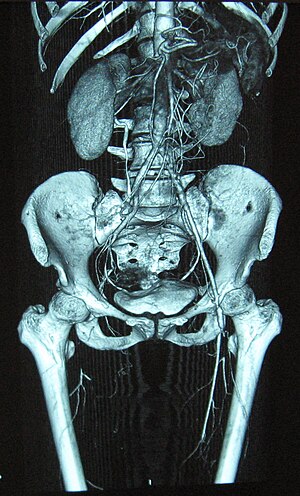Thromboangiitis obliterans
| Thromboangiitis Obliterans | |
|---|---|
| Synonyms | Buerger disease, Buerger's disease, Winiwarter-Buerger disease, presenile gangrene |
 |
|
| Complete occlusion of the right and stenosis of the left femoral artery as seen in a case of thromboangiitis obliterans | |
| Classification and external resources | |
| Specialty | cardiology |
| ICD-10 | I73.1 |
| ICD-9-CM | 443.1 |
| OMIM | 211480 |
| DiseasesDB | 1762 |
| MedlinePlus | 000172 |
| eMedicine | med/253 |
| Patient UK | Thromboangiitis obliterans |
| MeSH | C14.907.137.870 |
Thromboangiitis obliterans, also known as Buerger disease (English /bʌrɡər/, German /byrgər/), is a recurring progressive inflammation and thrombosis (clotting) of small and medium arteries and veins of the hands and feet. It is strongly associated with use of tobacco products, primarily from smoking, but is also associated with smokeless tobacco.
There is a recurrent acute and chronic inflammation and thrombosis of arteries and veins of the hands and feet. The main symptom is pain in the affected areas, at rest and while walking (claudication). The impaired circulation increases sensitivity to cold. Peripheral pulses are diminished or absent. There are color changes in the extremities. The colour may range from cyanotic blue to reddish blue. Skin becomes thin and shiny. Hair growth is reduced. Ulcerations and gangrene in the extremities are common complications, often resulting in the need for amputation of the involved extremity.
There are characteristic pathologic findings of acute inflammation and thrombosis (clotting) of arteries and veins of the hands and feet (the lower limbs being more common). The mechanisms underlying Buerger's disease are still largely unknown, but smoking and tobacco consumption are major factors associated with it. It has been suggested that the tobacco may trigger an immune response in susceptible persons or it may unmask a clotting defect, either of which could incite an inflammatory reaction of the vessel wall. This eventually leads to vasculitis and ischemic changes in distal parts of limbs.
...
Wikipedia
